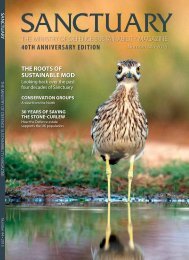SUSTAINABILITY
UBUt5
UBUt5
You also want an ePaper? Increase the reach of your titles
YUMPU automatically turns print PDFs into web optimized ePapers that Google loves.
FEATURES<br />
if ammunition gets into the waste<br />
stream. Landmarc therefore work<br />
closely with Ordnance, Munitions and<br />
Explosives (OME) Safety Offcers to<br />
engage estate users on the serious<br />
issue of the correct disposal of<br />
ammunition and pyrotechnics.<br />
Effective segregation<br />
and reuse<br />
In order to separate any improperly<br />
disposed-of ammunition before it<br />
leaves the training estate, Landmarc<br />
has installed waste sorting facilities on<br />
eight sites including Barr y Buddon,<br />
Otterburn, Stanford, Sennybridge, Lydd<br />
and Salisbury Plain. These have the<br />
added benefit of increasing the<br />
amount of waste we recycle, by<br />
segregating it safely and effectively<br />
prior to collection by our contractors.<br />
Waste types include paper, card, plastic,<br />
metals and waste wood that is<br />
untreated and non-hazardous.<br />
In other areas, food waste has<br />
been reduced by ensuring that all<br />
ingredients are optimised to meet<br />
busy mealtime demands, without<br />
surplus cooked food being prepared.<br />
Demolition waste is also often re-used<br />
by Landmarc in construction and<br />
maintenance projects.<br />
There is also a community focus when<br />
it comes to waste management, with<br />
Landmarc staff organising and taking<br />
part in litter picking and beach cleaning<br />
events. A recent collection at Lulworth<br />
saw the team clear around 200 bags of<br />
rubbish along six miles of UNESCO<br />
LANDMARC demolition waste Nesscliff © Landmarc Support Services<br />
Around 2,000 tonnes of demolition waste<br />
at Nesscliff was reused by Landmarc as road<br />
stone on the estate<br />
World Heritage Jurassic Coast. This was<br />
mainly pieces of non-biodegradable<br />
plastic and discarded fishing<br />
equipment, which can endanger<br />
marine life as well as littering the<br />
beaches. Cleaning up the beach also<br />
discourages others from littering and<br />
adds value to the local area.<br />
Case study: New tracks from old<br />
bunkers at Nesscliff: Many of the<br />
distinctive World War II bunkers on<br />
Nesscliff training area reached the end<br />
of their life in the last decade. Though<br />
the empty buildings were a well-used<br />
training feature they were structurally<br />
unsafe, posed a risk of falls from height<br />
and were costly to inspect and<br />
maintain. Approximately 2,000 tonnes<br />
of aggregate was generated from the<br />
first round of demolition, which was<br />
crushed and used by Landmarc as road<br />
stone on the estate. A second phase of<br />
demolition experimented with<br />
crushing a similar amount of rubble to<br />
a larger grade, a more effcient process<br />
which used less energy. The resulting<br />
crush is being used very successfully to<br />
improve safety and usability of training<br />
areas and was also used to create<br />
hardstanding areas for a mobile army<br />
hospital site at Nesscliff by Dutch<br />
engineers.<br />
and continuing along the ‘zero waste’<br />
journey. We must continue to work<br />
together to set challenging targets<br />
and strive to achieve our goal of<br />
preventing 100% of all waste from the<br />
training estate going to landfill.<br />
Using clear plastic sacks, adhering to<br />
camp Standing Orders, putting waste<br />
in the appropriately labelled bins and<br />
continuing to find ways of reducing<br />
and reusing waste items are all small<br />
but vital actions that can make a big<br />
difference to what we can achieve<br />
together to ensure the best possible<br />
environmental outcome for our waste.<br />
By working together, we can ensure the<br />
training estate remains environmentally<br />
sustainable for generations to come.<br />
Camilla Timms<br />
Sustainability Advisor<br />
Landmarc Support Services<br />
LANDMARC<br />
Waste hierarchy<br />
© Landmarc<br />
Support Services<br />
How we can work together<br />
All stakeholders including DIO,<br />
Landmarc staff, estate users and waste<br />
disposal suppliers have a key part to<br />
play in applying the waste hierarchy<br />
LANDMARC new tracks at Nesscliff<br />
© Landmarc Support Services<br />
Sanctuary 44 • 2015 25



